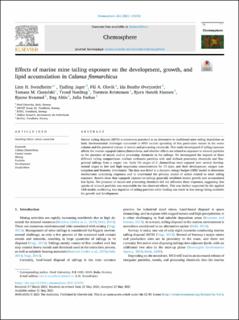| dc.contributor.author | Svendheim, Linn Hjelmeland | |
| dc.contributor.author | Jager, Tjalling | |
| dc.contributor.author | Olsvik, Pål Asgeir | |
| dc.contributor.author | Øverjordet, Ida Beathe | |
| dc.contributor.author | Ciesielski, Tomasz Maciej | |
| dc.contributor.author | Nordtug, Trond | |
| dc.contributor.author | Kristensen, Torstein | |
| dc.contributor.author | Hansen, Bjørn Henrik | |
| dc.contributor.author | Kvæstad, Bjarne | |
| dc.contributor.author | Altin, Dag | |
| dc.contributor.author | Farkas, Julia | |
| dc.date.accessioned | 2021-07-19T11:41:52Z | |
| dc.date.available | 2021-07-19T11:41:52Z | |
| dc.date.created | 2021-06-28T15:52:57Z | |
| dc.date.issued | 2021 | |
| dc.identifier.citation | Svendheim, L. H., Jager, T., Olsvik, P. A., Øverjordet, I. B., Ciesielski, T. M., Nordtug, T., Kristensen, T., Hansen, B. H., Kvæstad, B., Altin, D. & Farkas, J. (2021). Effects of marine mine tailing exposure on the development, growth, and lipid accumulation in Calanus finmarchicus. Chemosphere, 282: 131051. doi: | en_US |
| dc.identifier.issn | 1879-1298 | |
| dc.identifier.uri | https://hdl.handle.net/11250/2764770 | |
| dc.description.abstract | Marine tailing disposal (MTD) is sometimes practiced as an alternative to traditional mine tailing deposition on land. Environmental challenges connected to MTD include spreading of fine particulate matter in the water column and the potential release of metals and processing chemicals. This study investigated if tailing exposure affects the marine copepod Calanus finmarchicus, and whether effects are related to exposure to mineral particles or the presence of metals and/or processing chemicals in the tailings. We investigated the impacts of three different tailing compositions: calcium carbonate particles with and without processing chemicals and fine-grained tailings from a copper ore. Early life stages of C. finmarchicus were exposed over several developmental stages to low and high suspension concentrations for 15 days, and their development, oxygen consumption and biometry determined. The data was fitted in a dynamic energy budget (DEB) model to determine mechanisms underlying responses and to understand the primary modes of action related to mine tailing exposure. Results show that copepods exposed to tailings generally exhibited slower growth and accumulated less lipids. The presence of metals and processing chemicals did not influence these responses, suggesting that uptake of mineral particles was responsible for the observed effects. This was further supported by the applied DEB model, confirming that ingestion of tailing particles while feeding can result in less energy being available for growth and development. | en_US |
| dc.language.iso | eng | en_US |
| dc.publisher | Elsevier | en_US |
| dc.rights | Navngivelse 4.0 Internasjonal | * |
| dc.rights.uri | http://creativecommons.org/licenses/by/4.0/deed.no | * |
| dc.subject | zooplankton | en_US |
| dc.subject | particles | en_US |
| dc.subject | mining | en_US |
| dc.title | Effects of marine mine tailing exposure on the development, growth, and lipid accumulation in Calanus finmarchicus | en_US |
| dc.type | Peer reviewed | en_US |
| dc.type | Journal article | en_US |
| dc.description.version | publishedVersion | en_US |
| dc.rights.holder | © 2021 The Author(s) | en_US |
| dc.subject.nsi | VDP::Matematikk og Naturvitenskap: 400::Zoologiske og botaniske fag: 480::Økotoksikologi: 489 | en_US |
| dc.subject.nsi | VDP::Matematikk og Naturvitenskap: 400::Zoologiske og botaniske fag: 480::Økologi: 488 | en_US |
| dc.subject.nsi | VDP::Matematikk og Naturvitenskap: 400::Basale biofag: 470::Molekylærbiologi: 473 | en_US |
| dc.source.pagenumber | 10 | en_US |
| dc.source.volume | 282 | en_US |
| dc.source.journal | Chemosphere | en_US |
| dc.identifier.doi | 10.1016/j.chemosphere.2021.131051 | |
| dc.identifier.cristin | 1919047 | |
| dc.relation.project | The Norwegian Research Council: 281093 | en_US |
| dc.source.articlenumber | 131051 | en_US |

